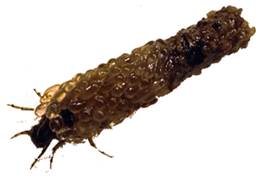In this post, Marco Konschak writes about their recently published paper “Waterborne and diet-related effects of inorganic and organic fungicides on the insect leaf shredder Chaetopteryx villosa (Trichoptera)”.
Leaf litter is one of the major carbon and nutrient sources for the entire biocenosis in low-order streams with forested catchments. By feeding on this leaf litter, detritivorous invertebrates (also called shredders) produce fine particulate organic matter, which can be consumed by other organisms. Furthermore, shredders serve as an important prey for predators such as fish.
However, certain anthropogenic chemicals, such as fungicides, can negatively affect shredders via two pathways: by direct exposure via the water phase (i.e., waterborne effect pathway) and by the uptake of fungicides adsorbed to the leaf litter as well as alterations in leaf-associated microbial communities, which play a pivotal role for leaves’ food quality for shredders (i.e., diet-related effect pathway). Hitherto, these fungicide-related effects were almost inclusively investigated for crustacean shredders. However, the functional feeding group of shredders comprises a variety of other taxonomic classes, for instance insects.

We examined waterborne and diet-related effects of an organic fungicide mixture (OFM) as well as the inorganic fungicide copper (Cu) in caddisfly larvae of Chaetopteryx villosa, a dominant insect shredder in headwater-forested acidic streams. Moreover, we compared the observed effect directions and sizes for C. villosa to those previously reported for the crustacean shredder Gammarus fossarum (see here for the respective study). We assessed the acute waterborne toxicity of OFM and Cu on the larval leaf consumption by exposing the larvae to the respective fungicide(s) via the water phase. Diet-related fungicide effects were investigated via food choice (a proxy for the palatability and thus the quality of a food source) of the larvae. For this, the caddisfly larvae were offered leaf material, which was microbially colonized in the absence or in the presence of the OFM or Cu. Furthermore, joint effects of both pathways on C. villosa’s leaf consumption and physiological fitness (estimated by measuring growth as well as lipid and protein content) were assessed after subjecting the larvae and their food for 24 and 12 days, respectively, to environmentally relevant OFM or Cu concentrations.

The crustacean and the insect shredder were of comparable sensitivity towards acute waterborne OFM exposure, whereas the larvae of C. villosa were more tolerant to Cu exposure via the water phase. Furthermore, both shredder species showed the same food choice behavior: leaves, which were microbially colonized in the absence of the OFM, were more palatable than those, which were exposed towards OFM. Furthermore, both species preferred leaves which were microbially colonized in the presence of Cu over non-exposed leaves. When C. villosa as well as G. fossarum were subjected for 24 days to both effect pathways in the OFM experiment, leaf consumption and the physiology of both shredders were negatively affected in both species. While no combined Cu effects were observed for larval leaf consumption, contrasting to the observations for G. fossarum, also this fungicide affected the physiology of both shredders negatively, despite partly differing effect patterns.
Our results suggest that the crustacean and the insect shredders are of comparable sensitivity to the OFM via both effect pathways, whereas C. villosa seems to be more tolerant towards waterborne Cu exposure. However, when both pathways act jointly, organic and inorganic fungicides can affect the physiology of shredder species belonging to different taxonomic classes. Since caddisflies constitute a subsidy for terrestrial predators, our study hence indicates that fungicides might not only affect the carbon and nutrient flux in aquatic ecosystems but also fluxes across ecosystem boundaries.
The paper was authored by Marco Konschak, Jochen Zubrod, Patrick Baudy, Dominic Englert, Bastian Herrmann, Ralf Schulz and Mirco Bundschuh, and published in Aquatic Toxicology.
